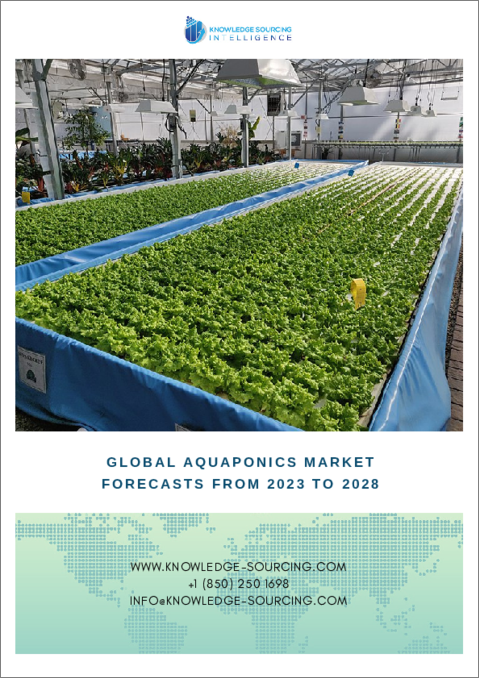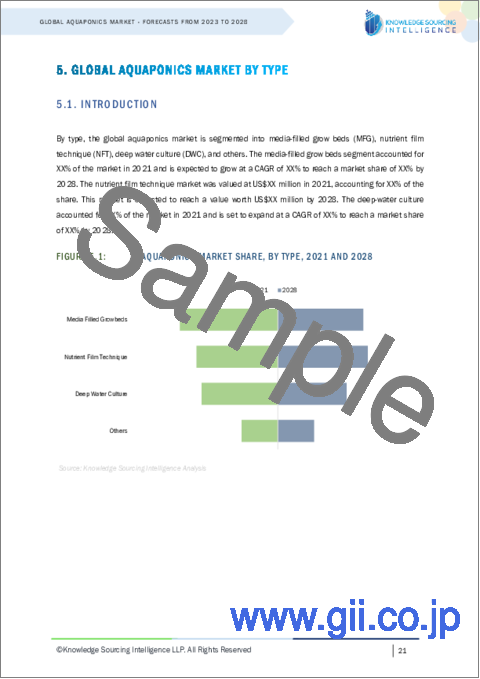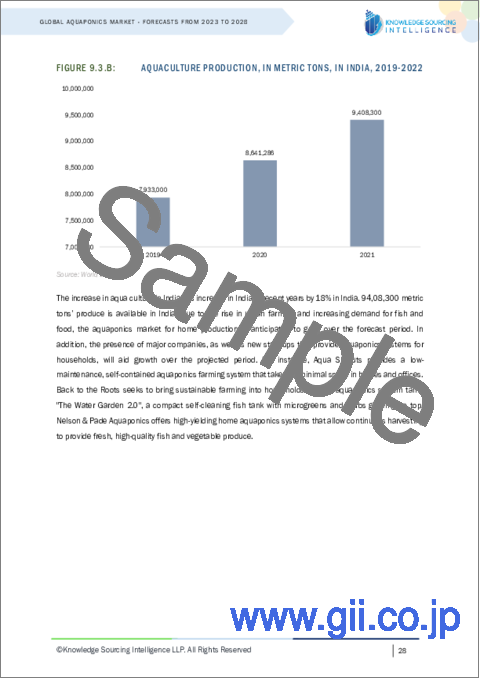|
|
市場調査レポート
商品コード
1295408
アクアポニックスの世界市場-2023年から2028年までの予測Global Aquaponics Market - Forecasts from 2023 to 2028 |
||||||
カスタマイズ可能
|
|||||||
| アクアポニックスの世界市場-2023年から2028年までの予測 |
|
出版日: 2023年06月15日
発行: Knowledge Sourcing Intelligence
ページ情報: 英文 145 Pages
納期: 即日から翌営業日
|
- 全表示
- 概要
- 目次
アクアポニックス市場はCAGR 5.86%で成長し、2021年の6億8,582万2,000米ドルから2028年には10億2,144万2,000米ドルになると予測されています。
アクアポニックスシステム市場は、予測期間を通じて、オーガニック製品に対する需要やオフシーズンの果物や野菜に対する嗜好とともに増加すると予測されます。加えて、必要な水量が少ないこと、技術的な複雑さが軽減されていること、二重飼育による収入の増加が業界拡大の主な要因となっています。
さらに、急速な工業化と都市化によって耕地が失われる可能性が高いため、アクアポニックス・システムが促進されると予想され、今後数年間で市場拡大に拍車がかかるとみられています。また、消費者の消費意欲の高まりは、エキゾチックな果物や野菜に対する需要を高め、予測期間を通じて市場の発展に寄与すると思われます。さらに、有機食品は有害な肥料や化学物質を含まないため、近年その利用が急増しています。
促進要因:
アクアポニックス技術の増加。
アクアポニックス技術の普及は、急速な都市化、アクセス可能な耕地面積の減少、環境に優しく持続可能な方法で地元で生産された食品に対する需要の高まりによって促進されています。土壌の劣化、淡水不足、気候変動といった困難に対処する従来の農業を助けるツールになり得る。さらに、より高品質で、より少ない農薬で生産された食品により多くの支出を惜しまない中間層の豊かさが拡大していることも、この分野への投資を後押ししています。有機食品に対する需要の高まりに対応するため、各国は農業慣行において最先端の技術とプロセスを導入する必要に迫られています。
政府の取り組み
水産養殖開発基金(ADF)は、2029年までに水産養殖の生産量を年間97万トンに引き上げたいと考えています。サウジアラビア政府は、この目標を達成するために、7,000万匹の幼魚用養殖場を建設する計画を発表しました。3億4,661万2,000米ドルの予算を持つこのプロジェクトは、環境・水・農業省、NEOM社、Tabuk Fish社によって承認されました。その目的は、アクアポニックスや水耕栽培などの最先端技術を導入することで、地元の養殖生産を増加させることです。
その結果、有機農産物への需要が高まり、有機野菜や果物の売り上げが伸びています。例えば、オーガニック・トレード・アソシエーションの2023年オーガニック産業調査によると、米国の売上高は2022年の600億米ドルから2023年には676億米ドルに増加しました。さらに、米国農務省は都市農業・革新的生産局を通じて750万米ドルを助成しました。さらに、米国農務省は家庭用アクアポニックス事業のガイドラインを発表し、米国農務省GAP監査プログラムを通じて監査を提供しました。
市場動向:
Aqua Sprouts社は、家庭やオフィスで最小限のスペースしか必要としない、低メンテナンスの自己完結型アクアポニックス農業システムを提供しています。バック・トゥ・ザ・ルーツ社は、アクアポニックス・システム水槽「ウォーターガーデン2.0」で、持続可能な農業を家庭に普及させようとしています。ネルソン&ペイド・アクアポニックスは、高収量の家庭用アクアポニックス・システムを提供しており、連続収穫が可能で、新鮮で高品質な魚や野菜が収穫できます。
培地床タイプは主要セグメントのひとつです。
アクアポニックス市場はタイプ別に、MFG(培地充填型栽培床)、NFT(薄膜水耕)、DWC(潅液水耕)、その他に区分されます。MFG方式のアクアポニックスは、植物の根を支えるために石や膨張粘土のような岩質の培地を詰めた容器を採用しており、水の使用量は少ないです。MFGの栽培床ユニットは、屋内または自家栽培の小規模アクアポニックスで最も人気のあるデザインです。
ほとんどの発展途上国では、この戦略を強く推奨します。世界人口は増加の一途をたどっており、国連の推計によれば、2050年までに食料消費量は50%増加し、野菜やその他の農産物の増産が必要となります。栄養不足の人々の数は、2019年と比較して2020年には1億1,800万人増加しています。こうした需要に応えるため、小規模な屋内アクアポニックス農法の導入が奨励されています。ショウガ、ニンジン、カブは、培地生産ベッド・アクアポニック・システムを通じて最も一般的に栽培されている作物です。これらの作物の消費量は増加の一途をたどっています。
家庭でのアクアポニックス生産
アクアポニックス市場は、エンドユーザー別に商業用、家庭用、研究用に分類されています。家庭でのアクアポニックス生産は、水を継続的に循環させることができるため、他の方法と比べて必要な水の量が最小限で済み、便利です。したがって、この技術は、低水と栄養豊富な土壌のない場所で使用することができます。アクアポニックスの家庭生産の成長は、健康意識の高まりによる果物や野菜の裏庭生産の増加に起因しています。アクアポニックスシステムは、スペースを節約するために、縦方向や横方向、また相互に重ねて作成することができます。
さらに、アクアポニックス業界では、商業用の温室を設置するために多額の初期費用が必要なため、家庭での生産がより魅力的になっています。家庭用アクアポニックスシステムに特化したフィルタリングシステムのため、家庭用アクアポニックス環境は、健康で栄養豊富な作物や魚を栽培することができます。例えば、ASTフィルターは、植物のために使用可能な栄養素に可溶性魚の排泄物を変換しながら、魚のための安全な水質を提供します。
地域別の洞察
地域的には、北米、欧州、中東・アフリカ、南米、アジア太平洋に分類されます。
インド市場の洞察
インドにおける水産養殖は近年18%増加しています。94,08,300トンの生産物がインドで入手可能です。都市型農業の増加や魚や食料の需要増により、家庭用アクアポニックス市場は予測期間中に成長すると予想されます。また、家庭向けにアクアポニックスシステムを提供する大手企業や新興企業の存在が、予測期間中の成長を後押しすると思われます。
目次
第1章 イントロダクション
- 市場概要
- 市場の定義
- 調査範囲
- 市場セグメンテーション
- 通貨
- 前提条件
- 基準年と予測年のタイムライン
第2章 調査手法
- 調査データ
- 前提条件
第3章 エグゼクティブサマリー
- 調査ハイライト
第4章 市場力学
- 市場促進要因
- 市場抑制要因
- ポーターのファイブフォース分析
第5章 アクアポニックスの世界市場:タイプ別
- イントロダクション
- MFG(培地充填型栽培床)
- NFT(薄膜水耕)
- DWC(潅液水耕)
- その他
第6章 アクアポニックスの世界市場:コンポーネント別
- イントロダクション
- バイオフィルター
- 沈砂池
- 水槽
- 土壌不使用の植物床
- 飼育水槽
- アクアポニックス農産物
- その他
第7章 アクアポニックスの世界市場:設備別
- イントロダクション
- ポンプ・バルブ
- 給湯器
- 魚類選別システム
- 通気システム
- 水質検査
- その他
第8章 アクアポニックスの世界市場:用途別
- イントロダクション
- 魚
- ハーブ
- 果物
- 野菜
第9章 アクアポニックスの世界市場:エンドユーザー別
- イントロダクション
- 商業用
- 家庭用
- 研究用
第10章 アクアポニックスの世界市場:地域別
- イントロダクション
- 北米
- 北米のアクアポニックス市場の分析:タイプ別
- 北米のアクアポニックス市場の分析:コンポーネント別
- 北米のアクアポニックス市場の分析:設備別
- 北米のアクアポニックス市場の分析:用途別
- 北米のアクアポニックス市場の分析:エンドユーザー別
- 国別
- 南米
- 南米のアクアポニックス市場の分析:タイプ別
- 南米のアクアポニックス市場の分析:コンポーネント別
- 南米のアクアポニックス市場の分析:設備別
- 南米のアクアポニックス市場の分析:用途別
- 南米のアクアポニックス市場の分析:エンドユーザー別
- 国別
- 欧州
- 欧州のアクアポニックス市場の分析:タイプ別
- 欧州のアクアポニックス市場の分析:コンポーネント別
- 欧州のアクアポニックス市場の分析:設備別
- 欧州のアクアポニックス市場の分析:用途別
- 欧州のアクアポニックス市場の分析:エンドユーザー別
- 国別
- 中東・アフリカ
- 中東・アフリカのアクアポニックス市場の分析:タイプ別
- 中東・アフリカのアクアポニックス市場の分析:コンポーネント別
- 中東・アフリカのアクアポニックス市場の分析:設備別
- 中東・アフリカのアクアポニックス市場の分析:用途別
- 中東・アフリカのアクアポニックス市場の分析:エンドユーザー別
- 国別
- アジア太平洋
- アジア太平洋のアクアポニックス市場の分析:タイプ別
- アジア太平洋のアクアポニックス市場の分析:コンポーネント別
- アジア太平洋のアクアポニックス市場の分析:設備別
- アジア太平洋のアクアポニックス市場の分析:用途別
- アジア太平洋のアクアポニックス市場の分析:エンドユーザー別
- 国別
第11章 競合環境と分析
- 主要企業と戦略分析
- 新興企業と市場収益性
- 合併、買収、合意およびコラボレーション
- ベンダー競争力マトリックス
第12章 企業プロファイル
- Aquaponic Lynx LLC
- GreenLife Aquaponics
- Nelson & Pade Aquaponics
- The Aquaponic Source
- ECF Farmsystems GmbH
- MyAquaponics
- Backyard Aquaponics
- NutraPonics Canada Corporation
- Symbiotic Aquaponic
- Endless Food Systems
The global aquaponics market is predicted to grow at a CAGR of 5.86%, from US$685.822 million in 2021 to US$1,021.442 million by 2028.
The market for aquaponics systems is anticipated to increase along with the demand for organic products and the preference for off-season fruits and vegetables throughout the forecast period. Additionally, lower water requirements lessened technical complexity, and increased income from dual-raising activities are the main drivers of industry expansion.
Additionally, the fast industrialization and urbanization likely to result in the loss of arable land are anticipated to promote aquaponics systems, which is expected to spur market expansion in the next years. Increased consumer spending power will also likely raise demand for exotic fruits and vegetables, which would help the market develop throughout the forecast period. Further, the use of organic food has surged in recent years since it doesn't include any hazardous fertilizers or chemicals.
Drivers:
Increase in aquaponics technology.
The spread of aquaponics technology is being fueled by rapid urbanization, a decrease in the amount of arable land accessible, and a rise in demand for food that is locally produced in an eco-friendly and sustainable manner. It is a possible tool to help conventional agriculture handle difficulties such as soil deterioration, freshwater scarcity, and climatic change. Further, the expanding middle-class affluence, which is ready to spend more for food of a higher quality and produced with fewer pesticides, is boosting investments in the sector. To meet the growing demand for organic food, nations have been pushed to embrace cutting-edge technologies and processes in their agricultural practices.
Government Initiatives
By 2029, the Aquaculture Development Fund (ADF) wants to raise aquaculture production to 970,000 tons annually. The Saudi government has announced plans to build 70 million fish farms for fingerlings to help achieve this goal. The project, which has a $346.612 million budget, was approved by the Ministry of Environment, Water, and Agriculture, NEOM Company, and Tabuk Fish Company. Its goal is to increase local aquaculture production by implementing cutting-edge technologies like aquaponics, hydroponics, and others.
As a result, the demand for organically farmed produce has increased the sales of organic fruits and vegetables. For instance, per the Organic Trade Association's 2023 Organic Industry Survey, sales increased from US$60 billion in 2022 to US$67.6 billion in 2023 in the United States. Further, The USDA granted $7.5 million through the Office of Urban Agriculture and Innovative Production. Moreover, USDA released guidelines for household aquaponics operations and provided auditing through the USDA GAP audit program.
Market Developments:
Aqua Sprouts provides a low-maintenance, self-contained aquaponics farming system that takes up minimal space in homes and offices. Back to the Roots seeks to bring sustainable farming into households with its aquaponics system tank, "The Water Garden 2.0", a compact self-cleaning fish tank with microgreens and herbs growing on top. Nelson & Pade Aquaponics offers high-yielding home aquaponics systems that allow continuous harvesting to provide fresh, high-quality fish and vegetable produce.
Media bed type is one of the major segments.
By type, the global aquaponics market is segmented into media-filled grow beds (MFG), nutrient film technique (NFT), deep water culture (DWC), and others. Aquaponics in the media bed method employs containers filled with rocky media such as stones or expanded clay to support plant roots and uses less water. The media-filled bed unit is the most popular design for small-scale aquaponics with indoor or homegrown products.
For most developing regions, this strategy is highly recommended. The world population is growing, and as per the estimates of the UN, food consumption will rise by 50% by 2050, developing a need for increased vegetable production and other agricultural products. The number of undernourished people has increased by 118 million in 2020 compared to 2019. To meet the demands, small-scale indoor aquaponics farming technique is encouraged to be adopted. Ginger, carrots, and turnips are the most commonly grown crops through media-produce bed aquaponic systems. The consumption of these crops is constantly rising.
Aquaponics production at home
The aquaponics market has been classified into commercial, home production, and research by end-user. Aquaponics production at home is convenient as it requires a minimal amount of water compared to other methods, as the water may be recirculated continually. Hence, this technique can be used in places with low water and without nutrient-rich soils. The growth of home production of aquaponics is attributable to increased backyard production of fruits and vegetables due to increased health consciousness. Aquaponics systems can be created vertically, horizontally, or layered on top of one another to save space.
Further, the significant initial expenditure required to set up a greenhouse in the aquaponics industry for commercial use makes home production more appealing. Due to specialized filtering systems for home aquaponics systems, home aquaponics environments can cultivate healthy, nutrient-rich crops and fish. For instance, AST filters offer safe water quality for fish while converting soluble fish waste into usable nutrients for plants.
Regional Insights.
Geographically, the global aquaponics market has been classified into North America, Europe, the Middle East and Africa, South America, and Asia Pacific.
Indian Market Insight:
Aquaculture in India has increased in recent years by 18% in India. 94,08,300 metric tons of produce is available in India. Due to the rise in urban farming and growing demand for fish and food, the aquaponics market for home production is anticipated to grow over the forecast period. In addition, the presence of major companies and new start-ups that provide aquaponics systems for households will aid growth over the projected period.
Market Segmentation:
By Type
- Media Filled Growbeds (MFG)
- Nutrient Film Technique (NFT)
- Deep Water Culture (DWC)
- Others
By Component
- Bio Filter
- Settling Basins
- Fish Tanks
- Soil-Free Plant Bed
- Rearing Tanks
- Aquaponic Produce
- Others
By Equipment
- Pumps and Valves
- Water Heaters
- Fish Purge Systems
- Aeration Systems
- Water Quality Testing
- Others
By Application
- Fish
- Herbs
- Fruits
- Vegetables
By End-User
- Commercial
- Home Production
- Research
By Geography
- North America
- United States
- Canada
- Mexico
- South America
- Brazil
- Argentina
- Others
- Europe
- UK
- Germany
- France
- Italy
- Others
- Middle East and Africa
- UAE
- Israel
- Saudi Arabia
- Others
- Asia Pacific
- China
- Japan
- India
- South Korea
- Taiwan
- Thailand
- Indonesia
- Others
TABLE OF CONTENTS
1. INTRODUCTION
- 1.1. Market Overview
- 1.2. Market Definition
- 1.3. Scope of the Study
- 1.4. Market Segmentation
- 1.5. Currency
- 1.6. Assumptions
- 1.7. Base, and Forecast Years Timeline
2. RESEARCH METHODOLOGY
- 2.1. Research Data
- 2.2. Assumptions
3. EXECUTIVE SUMMARY
- 3.1. Research Highlights
4. MARKET DYNAMICS
- 4.1. Market Drivers
- 4.2. Market Restraints
- 4.3. Porter's Five Force Analysis
- 4.3.1. Bargaining Power of Suppliers
- 4.3.2. Bargaining Power of Buyers
- 4.3.3. Threat of New Entrants
- 4.3.4. Threat of Substitutes
- 4.3.5. Competitive Rivalry in the Industry
- 4.3.6. Industry Value Chain Analysis
5. GLOBAL AQUAPONICS MARKET BY TYPE
- 5.1. Introduction
- 5.2. Media Filled Growbeds (MFG)
- 5.3. Nutrient Film Technique (NFT)
- 5.4. Deep Water Culture (DWC)
- 5.5. Others
6. GLOBAL AQUAPONICS MARKET BY COMPONENT
- 6.1. Introduction
- 6.2. Bio Filter
- 6.3. Settling Basins
- 6.4. Fish Tanks
- 6.5. Soil-Free Plant Bed
- 6.6. Rearing Tanks
- 6.7. Aquaponic Produce
- 6.8. Others
7. GLOBAL AQUAPONICS MARKET BY EQUIPMENT
- 7.1. Introduction
- 7.2. Pumps and Valves
- 7.3. Water Heaters
- 7.4. Fish Purge Systems
- 7.5. Aeration Systems
- 7.6. Water Quality Testing
- 7.7. Others
8. GLOBAL AQUAPONICS MARKET BY APPLICATION
- 8.1. Introduction
- 8.2. Fish
- 8.3. Herbs
- 8.4. Fruits
- 8.5. Vegetables
9. GLOBAL AQUAPONICS MARKET BY END-USER
- 9.1. Introduction
- 9.2. Commercial
- 9.3. Home Production
- 9.4. Research
10. GLOBAL AQUAPONICS MARKET BY GEOGRAPHY
- 10.1. Introduction
- 10.2. North America
- 10.2.1. North America Aquaponics Market Analysis, By Type
- 10.2.2. North America Aquaponics Market Analysis, By Component
- 10.2.3. North America Aquaponics Market Analysis, By Equipment
- 10.2.4. North America Aquaponics Market Analysis, By Application
- 10.2.5. North America Aquaponics Market Analysis, By End User
- 10.2.6. By Country
- 10.2.6.1. United States
- 10.2.6.2. Canada
- 10.2.6.3. Mexico
- 10.3. South America
- 10.3.1. South America Aquaponics Market Analysis, By Type
- 10.3.2. South America Aquaponics Market Analysis, By Component
- 10.3.3. South America Aquaponics Market Analysis, By Equipment
- 10.3.4. South America Aquaponics Market Analysis, By Application
- 10.3.5. South America Aquaponics Market Analysis, By End User
- 10.3.6. By Country
- 10.3.6.1. Brazil
- 10.3.6.2. Argentina
- 10.3.6.3. Others
- 10.4. Europe
- 10.4.1. Europe Aquaponics Market Analysis, By Type
- 10.4.2. Europe Aquaponics Market Analysis, By Component
- 10.4.3. Europe Aquaponics Market Analysis, By Equipment
- 10.4.4. Europe Aquaponics Market Analysis, By Application
- 10.4.5. Europe Aquaponics Market Analysis, By End User
- 10.4.6. By Country
- 10.4.6.1. United Kingdom
- 10.4.6.2. Germany
- 10.4.6.3. France
- 10.4.6.4. Spain
- 10.4.6.5. Others
- 10.5. Middle East and Africa
- 10.5.1. Middle East and Africa Aquaponics Market Analysis, By Type
- 10.5.2. Middle East and Africa Aquaponics Market Analysis, By Component
- 10.5.3. Middle East and Africa Aquaponics Market Analysis, By Equipment
- 10.5.4. Middle East and Africa Aquaponics Market Analysis, By Application
- 10.5.5. Middle East and Africa Aquaponics Market Analysis, By End User
- 10.5.6. By Country
- 10.5.6.1. Saudi Arabia
- 10.5.6.2. UAE
- 10.5.6.3. Others
- 10.6. Asia Pacific
- 10.6.1. Asia Pacific Aquaponics Market Analysis, By Type
- 10.6.2. Asia Pacific Aquaponics Market Analysis, By Component
- 10.6.3. Asia Pacific Aquaponics Market Analysis, By Equipment
- 10.6.4. Asia Pacific Aquaponics Market Analysis, By Application
- 10.6.5. Asia Pacific Aquaponics Market Analysis, By End User
- 10.6.6. By Country
- 10.6.6.1. China
- 10.6.6.2. Japan
- 10.6.6.3. India
- 10.6.6.4. South Korea
- 10.6.6.5. Taiwan
- 10.6.6.6. Thailand
- 10.6.6.7. Indonesia
- 10.6.6.8. Others
11. COMPETITIVE ENVIRONMENT AND ANALYSIS
- 11.1. Major Players and Strategy Analysis
- 11.2. Emerging Players and Market Lucrativeness
- 11.3. Mergers, Acquisitions, Agreements, and Collaborations
- 11.4. Vendor Competitiveness Matrix
12. COMPANY PROFILES
- 12.1. Aquaponic Lynx LLC
- 12.2. GreenLife Aquaponics
- 12.3. Nelson & Pade Aquaponics
- 12.4. The Aquaponic Source
- 12.5. ECF Farmsystems GmbH
- 12.6. MyAquaponics
- 12.7. Backyard Aquaponics
- 12.8. NutraPonics Canada Corporation
- 12.9. Symbiotic Aquaponic
- 12.10. Endless Food Systems





